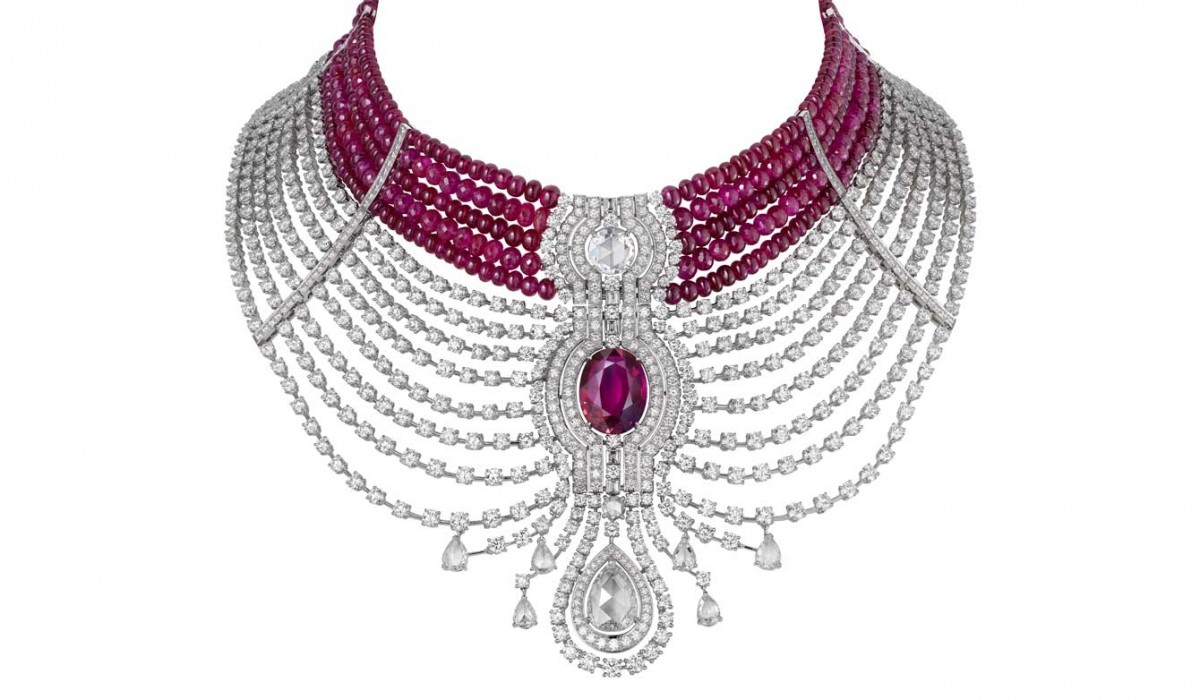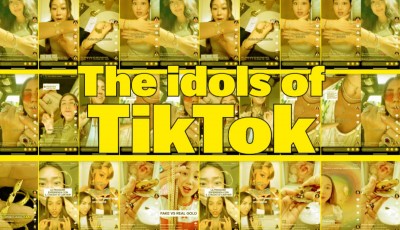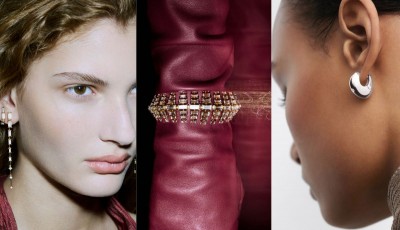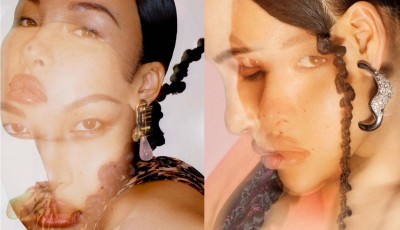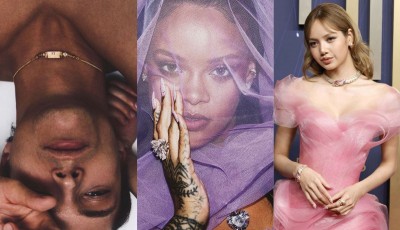The Re-immergence of the Ruby
‘A drop of the heart’s blood of Mother Earth’ is how the ruby is described in the Orient. The Indians call the ruby Ratnanayaka, the lord of the gemstones. The Hindus called the ruby the king of precious stones and the leader of gems.
[su_highlight background="#99788D" color="#FFFFFF"] GEMS[/su_highlight] It would be fair to say that the ruby has been eclipsed of late, by the dramatic resurgence in the popularity of the emerald. This is largely due to the ethical mining company Gemfields, who have successfully re-marketed the emerald as the coloured stone of choice, following several years of bad press surrounding undisclosed treatments to enhance colour and eliminate inclusions. Total transparency by Gemfields in the journey from mine to jewel has ensured it’s dramatic revival; and the same is about to happen to the ruby. Having acquired a 75% interest in a ruby mine in Mozambique back in February 2012, in June of this year, almost 0.4 tonnes of rough uncut rubies were brought to auction by Gemfields. And the result? They predict that by Christmas of this year, the presence of rubies within the Fine and High jewellery markets will be significantly increased.And the global market is more than ready for this surge. The highly prized Burmese ruby, in particular the deep red stones named ‘pigeon blood’ are increasingly rare as mining supply dwindles, while the US ban on their export sheds an extra controversial light on their choice. Historically the Chinese market have prized this gem, red being a signifier of wealth and joy; occasionally they have even been discovered buried in the foundations of buildings, placed there to bring good luck to the inhabitants. While in Indian culture the ruby has been considered the king of gemstones, favoured and cherished by Indian royalty. And similarly European Kings and Queens have prized this stone, often setting it as the principle gem in crowns and necklaces as a sign of immense wealth and stature. But for today’s western market is has recently lacked the clout and desirability of the emerald and sapphire, perhaps due to it’s difficulty to wear with Western skin-tones. Gemfields hope to change all of this; the spectrum of rubies found in Mozambique runs from a more flattering pinkish red, to a deep red that they believe is comparable to the Burmese pigeon blood.
Cartier’s Royal Collection is a celebration of exceptional stones - highlighting them as the key component in the designs, and (unusually for any jewellery House) disclosing their country of origin. Only 6 of over 100 pieces feature rubies, indicating their immense rarity. But a stand out necklace, the Reine Makéda, is the perfect embodiment of the collection’s raison d’etre. The design echoes the traditional African jewellery that is ubiquitous to the region where the 15.29 carat central ruby was sourced - it is designed to sit high on the neck, choker-style, and sweep down over the shoulders, with rows of ruby beads and diamonds reminiscent of tribal jewellery. In contrast an old mined Burmese ruby weighing over 10 carats and originally found in the Mogok valley is set simply in a ring, it’s deep red so strikingly different from the pinkish hues of the newly sourced Mozambican Reine Makéda stone.
[ts_row] [ts_one_half] 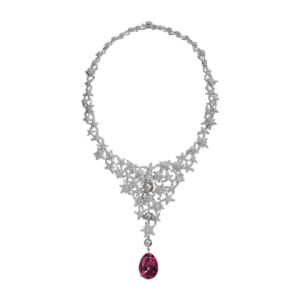 [/ts_one_half] [ts_one_half]
[/ts_one_half] [ts_one_half] 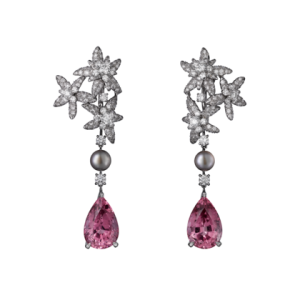 [/ts_one_half] [/ts_row]
[/ts_one_half] [/ts_row]
Dior have taken a different approach, using rubies as one of many colours in Victoire de Castellane’s palette. Her Archi Dior collection is a move away from the fantastical depictions of late and instead references the graphic silhouette’s of Christian Dior’s New Look. Rubies are used in a painterly way in the Ailée Diamant bracelet, the top of the cuff set with a wash of pinks, blues, purples and finally a hint of red, in a swirl of metal that appears folded and pleated to mimic fabric. In contrast rubies are unusually and dramatically set into the edges of the jewellery in the Corolle Soir ring and earrings. Cut into baguettes (a treatment usually reserved only for diamonds) they lend a vibrant flash of red to the compositions.
[ts_row] [ts_one_half]
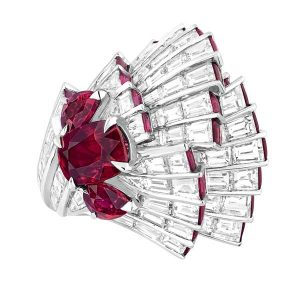 "Corolle Sour Rubis" ring with diamonds and rubies in white gold from the ArchidDior collection by Dior
"Corolle Sour Rubis" ring with diamonds and rubies in white gold from the ArchidDior collection by Dior
[/ts_one_half] [ts_one_half]
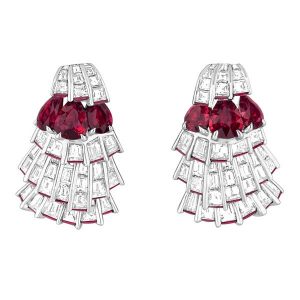 "Corolle Sour Rubis" earring with diamonds and rubies in white gold from the ArchidDior collection by Dior.
"Corolle Sour Rubis" earring with diamonds and rubies in white gold from the ArchidDior collection by Dior.
[/ts_one_half] [/ts_row]
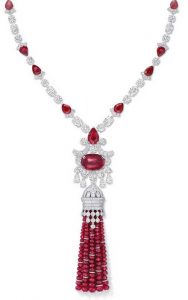 Ruby and Diamond Tassel necklace from Graff Diamonds
Ruby and Diamond Tassel necklace from Graff Diamonds
Graff Diamonds, who are renowned for handling the finest (and often largest gemstones), also have a history with the ruby. The Magok ruby, that they first acquired in 1988 and has passed through their hands 3 times, is 15.97 carats and originates from Burma, while the Graff Ruby, a cushion cut 8.62 carat stone is generally considered one of the best in existence due to its intense colour. This years Tassel collection pays homage to these gems, setting a ‘hero’ central ruby in a pendant or at the top of a pair of earrings and then off-setting them with a playful swish of ruby beads.
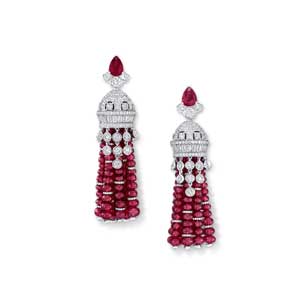
And Chopard’s Red Carpet Collection continues this more whimsical style – a pretty diamond and ruby flower necklace is one of many stars, while a diamond and ruby heart choker features 19 perfectly colour matched heart cut blood-red stones, at once gothic and fairytale in it’s depiction. Another unheated Burmese stand-out stone of 11.15 carats is given the reverence it deserves - set simply as a ring with a diamond pave surround and band.
[ts_row] [ts_one_third] 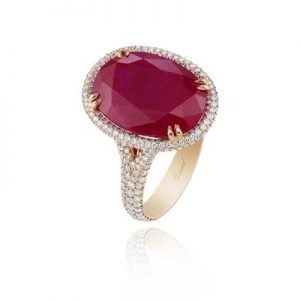 [/ts_one_third] [ts_one_third]
[/ts_one_third] [ts_one_third] 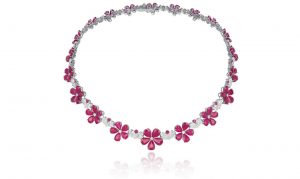 [/ts_one_third] [ts_one_third]
[/ts_one_third] [ts_one_third] 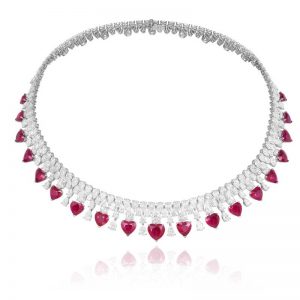 [/ts_one_third] [/ts_row]
[/ts_one_third] [/ts_row]
What seems evident from this years collections is that the global supply of rubies is scarce; smaller lower quality stones are cabochon cut and used as beads while exceptional and rare gems are given the space and position that they deserve - however these pieces are few and far between. But watch this space - it’s about to change, and the ruby will once again have it’s moment in the spotlight.
by Jessica Diamond


